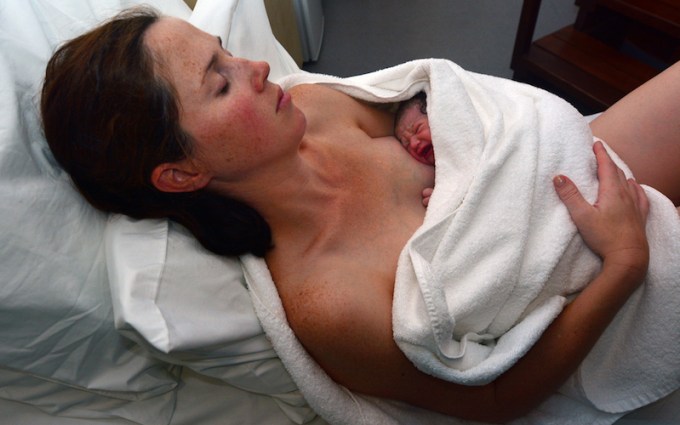Why are there more and more births by C-section?
There are complex reasons and assumptions about why this rate has increased so much in only 25 years. The WHO found in an investigation that only 10 – 15% of C-sections were medically necessary.
After hearing these statistics, one may assume that the increase of C-sections in Germany is based on the increased desire and demand for this procedure. However, only 2% of C-sections are performed at the request of the mother. The most plausible reason is thus a change in evaluating the risks for mother and child, and a change in the risk-benefit assessment. At the same time, the anesthesia and surgical techniques have changed a lot. Additionally, trained obstetricians are more likely to opt for a C-section to avoid risk, and thereby opt for a more defensive obstetric approach.
Furthermore, the assessment of high-risk pregnancies, advanced maternal age and an increase in average weight of mothers in industrialized countries may have played a role in the increase of C-sections.
The methods of performing C-sections has also changed: In Germany, all hospitals now practice “the gentle cesarean section according to Misgav-Laadach.” This surgical method makes much less use of sharp surgical tools; the mother’s tissue is rather stretched with the hands instead. This causes less injuries, reduces the necessary recovery time for the mom, and there is significantly less pain involved.

13 tips for how to prepare for a planned birth by C-section:
1. Make an appointment with the clinic to plan the day of the C-section in detail.
2. Write down your most important questions beforehand, so you don’t forget them.
3. Try to make the appointment with the clinic as close as possible to your baby’s estimated delivery date.
4. It is good for your baby to experience some light birthing stress through contractions before the planned C-section. This enables your baby to better expand its lungs, for example. For these reasons, birth is gently induced in some clinics before the C-section. During this process you experience mild contractions and thereby improve your baby’s arrival in the world. Ask your clinic if they offer this method.
5. Be sure to book a family room for the days after birth, that way your partner can stay with you and your baby and offer support.
6. Ask how bonding time after the C-section is designed and organized. When can you see your baby and have skin-to-skin contact?
7. Shave the area above your pubic bone to your navel by yourself the evening before.
8. Ask if you can have breakfast in the morning before the appointment.
9. Inform your midwife about the scheduled appointment so that she, too, can plan on visiting you afterwards.
10. Discuss with your midwife what you should pay attention to when you are breastfeeding after the C-section during your stay in the hospital. Taking some of your first milk (known as colostrum) to the clinic is a wise idea. This can make breastfeeding easier, and if your baby has some mild difficulties after birth you can give him or her this milk. Ask your midwife how you can best extract this valuable breast milk.
11. To facilitate skin contact with your baby, bring a soft towel of yours to the clinic to wrap up your baby afterwards … the towels at the clinics are often washed with disinfectant and are scratchy on the sensitive baby skin. Contact with your skin gives the baby warmth and security, strengthens the bonding effect, and favors the first breastfeeding after birth.

12. Discuss with your partner in advance how many visits you would like to have in the clinic in the first few days and who should come over.
13. Once you have a fixed appointment, you can plan the following week after being sent home well in advance and ask your friends and family to support you.
Tips for the C-section during delivery
During the birth of your baby, an unplanned C-section may also occur. Until the final decision is made, you, your partner, the doctors and midwives, will be involved in the decision-making process. The midwife in the delivery room will then explain exactly how the procedure will go and what exactly will happen to you.
Make sure to ask when you can see your baby here as well and how the first hour after the birth will be. Maybe your partner can also do the initial bonding with skin-to-skin contact. Your baby knows the smell of your partner as well as yours, which will offer it comfort.

It’s bright and loud in an operating room. Make sure that your baby is wrapped up nice and warm and is placed either on your chest or your partner’s chest. Cover it well to protect it from the harsh bright lights.
In Germany, women are discharged from the hospital after a birth by C-section roughly on the fourth or fifth day. If you are already feeling well on the third day and you feel comfortable and safe, ask the clinic at any time whether you can go home sooner. In this case, inform your midwife about your dismissal before you go home, so that she can support you promptly.
What happens after a C-section?
Being free of discomfort and getting through everyday life again normally takes slightly longer after a C-section than recovery after a normal birth. After a C-section, you should look after yourself longer and more intensely. Get help with the household if necessary. Your midwife will accompany you through the wound healing process and provide you with tips that support the healing process.
Please wait at least eight weeks before starting the postpartum recovery process. Caesarean birth can be harder for some moms to handle emotionally. Take your time and acknowledge this! Talk to your midwife and above all your partner about your feelings and enjoy the fact that you and your baby are both well.



